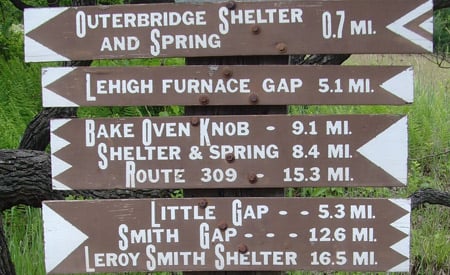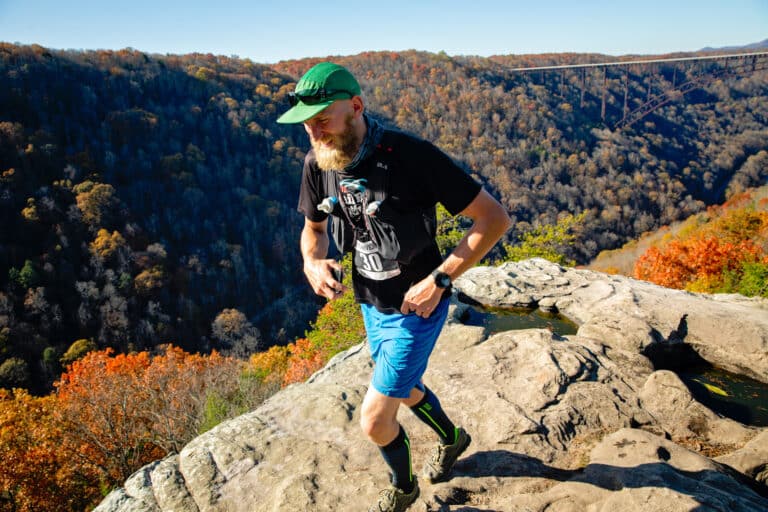“Hold your nose; we’re gettin’ near Palmerton!” Dan Kunkle was talking about a factory town in Pennsylvania’s Lehigh Gap, where the Appalachian Trail (A.T.) descends from the Kittatinny Ridge to cross the Lehigh River. It was impossible to hold your breath for the entire car ride past it, but we tried anyway, because the place “stank real bad.”
However, my chat with Dan was no joke. He was telling how he and other locals took the region’s biggest environmental liability and built an asset.
A CONTROVERSIAL MOONSCAPE
I experienced my first big hike in the Gap on a day in the 1970s when the air was clear. I didn’t know why the mountain we were climbing was bare; I just thought it was cool. Void of vegetation, nothing blocked the view. It was as if we were above treeline but without the high-altitude wheeziness or plantlife. Since I’d never known anyone to be outraged or shocked about the condition, I thought all was fine.
However, things were very wrong. For almost a century, smelting at the Palmerton Zinc Factory emitted sulfur dioxide (which became sulfuric acid smog) and tons of zinc, lead, cadmium, and arsenic every year. Vegetation died; soil washed away. What remained, including 449 acres of National Park Service (NPS)-managed land around the A.T., couldn’t support life because it was heavily dusted with metals. In 1983, the Environmental Protection Agency (EPA) designated the scene as a National Priority Superfund site.
Palmerton residents, though, felt the EPA could keep its super-polluted judgment; their loyalties remained with the factory. They were grateful to the New Jersey Zinc Company for their town, hospital, school, borough hall (now doubling as a hikers’ hostel), and prosperity. Plant employees even refused to let their grassless yards be tested for fear of further tarnish to the company’s reputation. An unforeseen ecosystem collapse did not represent the company they knew.
Through mergers and provisions in the Superfund law, a media giant that never smelted zinc–CBS Corporation Inc.–became responsible for the cleanup. Thousands of acres of steep slopes needed fixing, most with high winds and eroded soil. The site sat for years.
Then, in the late 1990s, EPA engineers spread and seeded manufactured soil on an 800-acre section. Although vegetation grew, 60 miles-worth of expensive and undesirable switchback roads had to be built to get it done. The site sat again.
Meanwhile Dan Kunkle, a school teacher, and his cohorts were looking for a place to build an environmental education center. Eventually, they acquired toxic land within CBS’s liability area for the Lehigh Gap Nature Center. A team of area residents along with John Dickerson, retired from the U.S. Department of Agriculture, hatched a plan for CBS to get something growing on the Center’s piece of the moonscape. They wanted to spread warm-season grass seed with a crop duster. The project was ambitious in that it needed experts to try something they didn’t think would work, yet it was simple in that it gave control to nature.
Dan quit his 28-year teaching job, gave up his tenure and full pension, and took on a 70-hour-per-week workload to keep the mountain-healing dream alive. “Somebody had to do this full time or it would fall apart,” Dan said. Amid strong skepticism, he convinced CBS to try. The seed was scattered, nature chipped in some rain, the mountain turned green, and the community smiled.
Still, the A.T.-crossing ridgeline, east and west of Lehigh Gap, remained barren. Eventually, the National Park Service used 70 fenced-in acres near the trail to give 15,000 seedlings protection from hungry deer.
COLLABORATION SUCCESS
Charlie Root, the site’s original remedial project manager, described his experience with the Center as uniquely collaborative. Plus, he said, “One of the most satisfying outcomes at any of my sites in my 20-year career at EPA is to have an actual environmental education center on a site where people can actually come in and see the progress we’ve made and learn about Superfund and environmental science at the same time.”
The Center is A.T.-accessible via the Woodpecker Trail. Hiking north, after crossing the river and then under power lines on the re-ascent, orange blazes on the right take you a half-mile to the building. There you can see historic photos of the factory and the moonscape, get some water, and maybe even meet Dan.
The work is still not done. Even the educators are learning as they conduct research to watch nature’s reaction. Still, their story is a shining example of how people can care enough to heal mountains.







